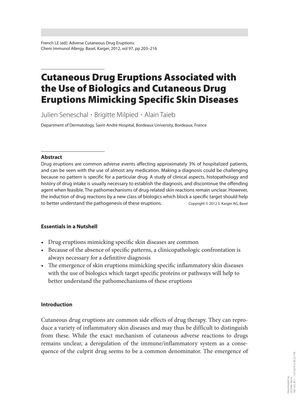Cutaneous Drug Eruptions Associated with the Use of Biologics and Cutaneous Drug Eruptions Mimicking Specific Skin Diseases
January 2012
in “
Chemical Immunology
”

TLDR Some drugs, especially biologics, can cause skin reactions that look like other skin diseases, and stopping the drug usually helps clear up these reactions.
The document from 2012 reviews cutaneous drug eruptions, which affect about 3% of hospitalized patients, and the challenges in diagnosing these conditions due to their resemblance to idiopathic skin diseases. It specifically focuses on the effects of biologics, which can induce skin eruptions that mimic diseases like psoriasis, lichenoid eruptions, vasculitis, and lupus erythematous-like eruptions. The document details the clinical presentation, histopathological findings, and drugs commonly associated with these reactions, including the role of type I interferons in the pathogenesis of biologic-induced psoriasiform eruptions. It also covers drug-induced hair loss and changes in hair structure caused by EGFR inhibitors. The importance of discontinuing the offending drug is highlighted as a primary treatment, with the resolution of many skin reactions following cessation and sometimes requiring additional treatments. The paper underscores the need for physician awareness of these drug reactions and their potential to inform the understanding of common inflammatory skin disorders.




